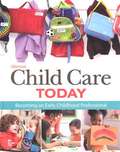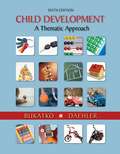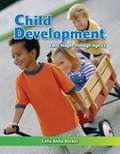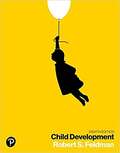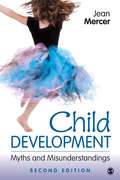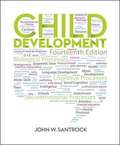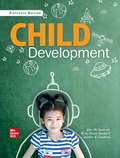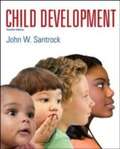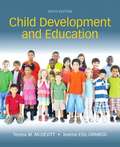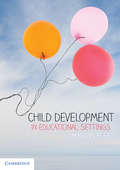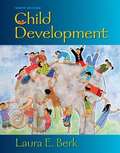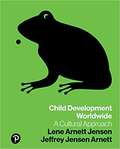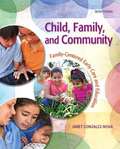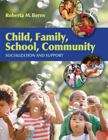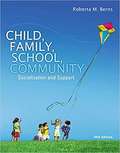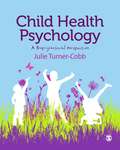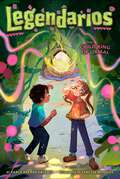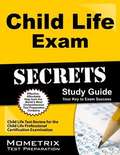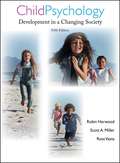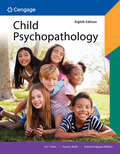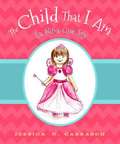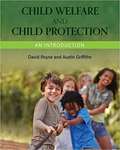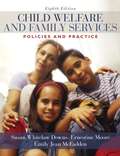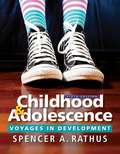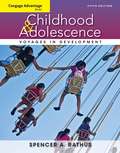- Table View
- List View
Child Development: A Thematic Approach
by Danuta Bukatko Marvin W. DaehlerBukatko/Daehler's CHILD DEVELOPMENT: A THEMATIC APPROACH provides a comprehensive, topically organized, up-to-date picture of development from conception to adolescence. Most important, it draws students' attention to the themes that replay themselves throughout the course of development, fundamental issues that resurface continually and that provide coherence to sometimes seemingly disparate research. The themes can serve as frameworks to help students further understand and remember the multitude of facts about child development. Bukatko/Daehler's sixth edition text draws on five themes, Nature and Nurture, Sociocultural Influence, Continuity/Discontinuity, Interaction among Domains, and Risk/Resilience. By drawing on these themes, the authors hope to stimulate readers to think about the process of development, or why it proceeds as it does. Through new For Your Review and Reflection sections, the authors also hope students will engage with the text and become more adept critical thinkers, who are more likely to appreciate the ramifications of theory and research for applied issues such as parenting practices, education, and social policy for children, which are ultimately concerns for us all.
Child Development: Early Stages Through Age 12, 7th Edition
by Celia A. DeckerChild Development: Early Stages Through Age 12 is designed to help students understand how to work with and care for children as they grow. The contents of this authoritative text focus on guiding children#x19;s development and meeting developmental needs from the prenatal stage through the school-age years. The text also explores play activities, ways to keep children healthy and safe, group programs, and child-related careers. Many examples are provided to help apply this information when working with children of all ages.
Child Development
by Robert S. FeldmanA balanced presentation of developmental theory, research, and applications <p><p> Child Development, Eighth Edition offers students a balanced, up-to-date overview of developmental theory and research with a focus on application to students’ personal lives and future careers. <p><p> Organized chronologically, the text features a variety of student-focused tools that make the study of development interesting and engaging. Author Robert Feldman’s emphasis on practical, take-home information provides students with knowledge they can use during the course and beyond.
Child Development: Myths and Misunderstandings (2nd Edition)
by Jean MercerIn Child Development: Myths and Misunderstanding Second Editions, Jean Mercer uses intriguing vignettes and questions about children and families to guide readers in thinking critically about 59 common beliefs. Each essay confronts commonly held misconceptions about development, encouraging students to think like social scientists and to become better consumers of media messages and anecdotal stories.
Child Development: An Introduction (Fourteenth Edition)
by John W. SantrockThorough. Accurate. Reliable. Engaging. These are just a few of the words used by adopters and reviewers of John Santrock's Child Development. The new topically-organised fourteenth edition continues with Santrock's highly contemporary tone and focus, featuring over 1,000 new citations. The popular Connections theme shows students the different aspects of children's development to help them better understand the concepts. Used by hundreds of thousands of students over thirteen editions, Santrock's proven learning goals system provides a clear roadmap to course mastery.
Child Development: An Introduction
by John W. Santrock Kirby Deater-Deckard Jennifer LansfordThorough. Accurate. Reliable. Engaging. These are just a few words used by adopters and reviewers of John Santrock's Child Development. The topically-organized fifteenth edition continues with Santrock's highly contemporary tone and focus, featuring over 1,000 new citations. The popular Connections theme shows students the different aspects of children's development to help them better understand the concepts. Used by hundreds of thousands of students over fourteen editions, Santrock's proven learning goals system provides a clear roadmap to course mastery.
Child Development (12th edition)
by John W. SantrockA standard textbook that emphasizes an extremely up-to-date (more than 250 references from 1993, 1994, and in-press sources) presentation of research in the three primary domains of child development: biological processes, cognitive processes, and socioemotional processes. The changes in this edition include increased and updated coverage of culture, ethnicity, and gender; families and parenting; and health and well-being. Annotation c. by Book News, Inc., Portland, Or.
Child Development and Education
by Teresa McDevitt Jeanne OrmrodWritten by a developmentalist and an educational psychologist, Child Development and Education bridges the gap between theory and practice, showing those who teach and care for infants, children, and adolescents how to apply developmental research and theory to everyday practice. This topically organized text describes developmental phenomena and provides instruction and opportunities to practice observations of and analyses of what children say, do, and create, ensuring that educators can make informed decisions that meet children's and adolescents' needs. The Enhanced Pearson eText features embedded video, assessments, teacher certification exam prep, and video analysis exercises.
Child Development in Educational Settings
by Marilyn FleerChild Development in Educational Settings provides a comprehensive introduction to traditional and contemporary theories of development and learning in the contexts of early childhood and primary education. Drawing upon the experiences and perspectives of children, families, educators and Aboriginal and Torres Strait Islander scholars, Marilyn Fleer provides insights into significant theories and approaches, including cultural-historical, constructivist, social constructivist, maturational and ecological systems. The book features four major case studies, which are revisited throughout, to examine how learning and development can be reimagined within socially, culturally and linguistically diverse communities. This approach enables readers to use theories to analyse and measure learning and development in planning and curriculum, and to feel empowered to enact change in their educational settings. Written in an engaging and accessible style, Child Development in Educational Settings is an essential resource for pre-service teachers and professionals alike.
Child Development (Ninth Edition)
by Laura E. BerkA best-selling, topically organized child development text, Berk’s Child Development is relied on in classrooms worldwide for its clear, engaging writing style, exceptional cross-cultural and multi-cultural focus, rich examples, and long-standing commitment to presenting the most up-to-date scholarship while also offering students research-based, practical applications that they can relate to their personal and professional lives. Berk takes an integrated approach to presenting development in the physical, cognitive, emotional, and social domains; emphasizes the complex interchanges between heredity and environment; and provides exceptional attention to culture. Laura Berk, renowned professor and researcher, presents the latest theories and findings in the field to students in a manageable and relevant way. Berk’s signature storytelling style invites students to actively learn beside the text’s “characters,” who experience real issues in development, including physical, cognitive, and peer challenges, as well as parenting and educational concerns. Berk also helps students connect their learning to their personal and professional areas of interest. Her voice comes through when speaking directly about issues students will face in their future pursuits as parents, educators, heath care providers, social workers, and researchers. As members of a global and diverse human community, students are called on to intelligently approach the responsibility of understanding and responding to the needs and concerns of children. While carefully considering the complexities of child development, Berk presents classic and emerging theories in an especially clear, engaging writing style, with a multitude of research-based, real-world, and cross-cultural examples. Strengthening the connections among developmental domains and among theory, research, and applications, this edition's extensive revision brings forth the most recent scholarship, representing the changing field of child development.
Child Development Worldwide: A Cultural Approach
by Lene Jensen Jeffrey ArnettChild Development Worldwide presents a topical examination of all stages of development — from prenatal development through middle childhood, adolescence, and emerging adulthood — through the engaging lens of culture. Cross-cultural examples integrated throughout the narrative reveal the impact of cultural factors both in the US and around the world. Authors Lene Arnett Jensen and Jeffrey Jensen Arnett emphasize culture to foster a thorough, balanced view of development that prepares students to face challenges in our diverse and globalized world — whether they travel the globe or remain in their hometowns.
Child, Family, and Community: Family-Centered Early Care and Education 6th Edition
by Janet Gonzalez-MenaThe sixth edition of Child, Family, and Community: Family-Centered Early Care and Education continues to provide you with essential information in a friendly and assessable manner. It discusses the socialization and education of young children in home, child care, and educational contexts from birth to 8 years old. The sixth edition is written to and provides concrete strategies for a broader audience to better meet the needs of aspiring professionals of all types including educators, social workers, and parents. The theme of the revision is advocacy and new Advocacy in Action features present personal stories of well known professionals who have made a difference in the lives of others. This new edition will truly inspire you to become an advocate to improve the lives of children and families, education, and society.
Child, Family, School, Community: Socialization and Support (Eighth Edition)
by Roberta M. BernsBerns' CHILD, FAMILY, SCHOOL, COMMUNITY (CFSC) is intended for child, family, school, and community relations courses offered in both community and 4-year colleges. CFSC examines how the school, family, and community influence children's socialization. Roberta Berns uses Bronfenbrenner's Bioecological Model of Human Development as a framework. Courses for which CFSC is appropriate are often titled: Socialization of the Child; Child and Society, or Child in Society; Child, Family, and Community; or Child Development in the Family and Community. The course is frequently taken by future teachers, education paraprofessionals (e. g. , child care workers), and psychology, sociology or human ecology majors. The course can be found in various departments, including Human/Child Development, Early Childhood Education; Child/Family Relations; Sociology; Psychology or Psychology/Social Behavior; Home Economics; Human or Social Ecology, and Teacher Education. The course is a requirement for California Early Childhood Education certification and is offered at most California community colleges.
Child, Family, School, Community: Socialization And Support
by Roberta M. BernsThe best-selling CHILD, FAMILY, SCHOOL, COMMUNITY: SOCIALIZATION AND SUPPORT, now in its Tenth Edition, offers an excellent introduction to socialization that is grounded in a powerful conceptual framework-Urie Bronfenbrenner's Bioecological Model of Human Development. Examining how the school, family, and community influence children's socialization, this book addresses complex issues in a clear, comprehensive fashion. An enjoyable read, it's packed with meaningful, timely examples and learning aids that ensure you gain a solid understanding of chapter concepts. A sensitive presentation of diversity issues includes matters related to culture, ethnicity, gender, sexual orientation, socioeconomic status and special needs. Updated throughout, this edition features a strong emphasis on NAEYC and NASW standards as well as a new neuroscience feature called �Brain Briefs.�
Child Health Psychology: A Biopsychosocial Perspective
by Dr Julie Turner-CobbChild Health Psychology: A Biopsychosocial Perspective is the first sole-authored textbook dedicated to the topic of health psychology as it applies to children and adolescents, drawing on research from several related disciplines including psychoneuroimmunology and developmental psychobiology. With an overarching biopsychosocial lifespan perspective, Turner-Cobb examines the effects of early life experience on health outcomes, as well as covering the experience of acute and chronic illness during childhood. Lots of helpful aids are provided per chapter including key learning objectives, textboxes putting spotlights on key pieces of research, lists of key concepts to revise, useful websites and further reading suggestions.<P> With a perspective designed to both inform and to challenge, this stimulating textbook will introduce you to the central relevance and many applications of child health psychology. It will be of interest to final year undergraduate and postgraduate students in health and clinical psychology, as well as to students in health sciences, nursing, and childhood studies.
The Child King of Uxmal (Legendarios #3)
by Karla Arenas ValentiTwins Emma and Martín help a potential king earn his throne in this third book in the Legendarios chapter book series that&’s Magic Tree House meets Heroes in Training! Emma and Martín swap the cool Chicago fall for the hot jungles of the Puuc Hills when they dive into the myth of the Child King of Uxmal. There, they meet Nicte the healer. Nicte is determined to save her village from constant droughts and the burden of their ruthless king. She&’s following rumors of a prophecy, which leads her to three strange items: a giant egg and a drum and rattle that will only play for the rightful king of Uxmal. Emma and Martín are eager to help Nicte follow the prophecy when they are yanked out of the jungle—and discover that there&’s a page missing from their book! Can the twins find a way back into the legend to save Nicte&’s village, or is this the end of the story?
Child Life Exam Secrets Study Guide: Child Life Test Review for the Child Life Professional Certification Examination
by Child Life Exam SecretsChild Life Exam Secrets helps you ace the Child Life Professional Certification Examination, without weeks and months of endless studying. Our comprehensive Child Life Exam Secrets study guide is written by our exam experts, who painstakingly researched every topic and concept that you need to know to ace your test. Our original research reveals specific weaknesses that you can exploit to increase your exam score more than you've ever imagined. Child Life Exam Secrets includes: The 5 Secret Keys to Child Life Exam Success: Time is Your Greatest Enemy, Guessing is Not Guesswork, Practice Smarter, Not Harder, Prepare, Don't Procrastinate, Test Yourself; A comprehensive General Strategy review including: Make Predictions, Answer the Question, Benchmark, Valid Information, Avoid Fact Traps, Milk the Question, The Trap of Familiarity, Eliminate Answers, Tough Questions, Brainstorm, Read Carefully, Face Value, Prefixes, Hedge Phrases, Switchback Words, New Information, Time Management, Contextual Clues, Don't Panic, Pace Yourself, Answer Selection, Check Your Work, Beware of Directly Quoted Answers, Slang, Extreme Statements, Answer Choice Families; A comprehensive Content review including: Normalization, Dignity of Risk, Competence Motivation Theory, JACHO, Cultural Competence, Caring, Vicarious Play, Emancipated Minor, Negative Event/Positive Outcome, Transactional Stress Model, Sensorimotor Stage, Anticipatory Grief, Mary Salter Ainsworth, Autonomy, Imminent Justice, IDEA, Projective Artwork, End phase Consequences, Association for Play Therapy, Family Resource Center, Fiduciary, American Academy of Pediatrics, Therapeutic Play, Postvention, Advocate, Family-to-Family Support, Industry vs. Inferiority Stage, Coping, Annual Report, NIDCAP, Pediatric Home Health Care, FICA, Bolig, Best Interests, Intervention, Relaxation Response, and much more. . .
Child Psychology: Development In A Changing Society
by Ross Vasta Scott A. Miller Robin HarwoodIn this comprehensive overview, readers will gain a better understanding of the various theories, perspectives, and research that characterize contemporary themes in child development. The book uses a contextual approach to examine the biological, cognitive, social, and emotional foundations of child development. Special attention is paid throughout to the contexts in which development occurs, including families and the larger culture, and how these intersect with our changing society.
Child Psychopathology
by Eric J. Mash David A. Wolfe Katherine T. Nguyen WilliamsMash/Wolfe/Nguyen Williams' CHILD PSYCHOPATHOLOGY, 8th Edition, introduces you to childhood and adolescent disorders, treatments and preventions with an approach that recognizes the interconnectedness of biological, psychological, social and emotional influences. You'll learn about each disorder from the perspective of the whole child, with diagnostic criteria and an emphasis on the individual's strengths, environmental circumstances, issues regarding younger and older age groups and the risk and protective factors affecting developmental pathways. Case histories, examples and first-person accounts are at the heart of the text, bringing to life theories and disorders and the real people affected by them.
The Child That I Am
by Jessica CarrascoThe Child that I Am is a loving book that aim to involve parents and children in their day by day activities with love and respect.
Child Welfare And Child Protection
by David Royse Austin GriffithsChild Welfare and Child Protection: An Introduction prepares future child welfare professionals to tackle the complex and challenging work associated with responding to child maltreatment. Developed by a former child protection professional and a social work scholar, this book draws upon current research and features cases that simulate those child welfare professionals are likely to encounter in the field. After an historical examination of the evolution of child protection in the United States, the book focuses on understanding the causes of child maltreatment and risk assessment. Readers are presented with a compelling case and the opportunity to see how it develops over the course of three chapters that address the investigative process, the delivery of ongoing services to assist families in addressing high-risk behaviors, and helping children achieve timely permanency when returning home is not an option. Other chapters present foster parent and foster child perspectives, additional considerations for special needs populations, and suggestions for working effectively on a child protection team. Every effort is made to prepare readers for the stresses and strains associated with working in child protection, including a dedicated chapter on self-care. Featuring foundational and critical information for future professionals, Child Welfare and Child Protection is well-suited for introductory undergraduate and graduate courses. David Royse is a professor of social work at the University of Kentucky. He is the author of 10 books on multiple topics and numerous professional articles exploring issues in mental health, healthcare, research, program evaluation, and child welfare. Previously a child welfare practitioner in the commonwealth of Kentucky, Austin Griffiths is an assistant professor at Western Kentucky University. Dr. Griffiths is passionate about improving the lives of vulnerable children and their families, as well as supporting and advocating for a healthy and vibrant child welfare workforce.
Child Welfare and Family Services: Policies and Practice (Eighth Edition)
by Susan Downs Ernestine Moore Emily Jean McfaddenIntended for use in collaborative programs bringing together public child welfare agencies and schools of social work, this textbook takes a deliberately broad approach to child services. Chapters concentrate on topics like rights and responsibilities, the prevention of maltreatment, day care and child development programs, family income security, court intervention, protection from neglect and abuse, family preservation, foster care, adoption, delinquency, and professional responsibilities. Annotation ©2004 Book News, Inc., Portland, OR (booknews.com)
Childhood and Adolescence: Voyages In Development
by Spencer A. RathusSpencer A. Rathus provides a hands-on approach in the chronologically organized CHILDHOOD AND ADOLESCENCE: VOYAGES IN DEVELOPMENT, Sixth Edition, to help you understand the link between developmental theories and research as well as their application to your everyday life. Using his proven pedagogical approach, interspersed with personal and humorous stories, Rathus makes reading and studying an enjoyable process of discovery.
Childhood and Adolescence: Voyages in Development (Fifth Edition)
by Spencer A. RathusSpencer A. Rathus provides a hands-on approach in the chronologically organized CHILDHOOD AND ADOLESCENCE: VOYAGES IN DEVELOPMENT, Fifth Edition, augments your goal of helping students understand the link between developmental theories and research and their application to everyday life. Using his proven pedagogical approach, interspersed with personal and humorous stories, Rathus makes reading and studying an enjoyable process of discovery.
